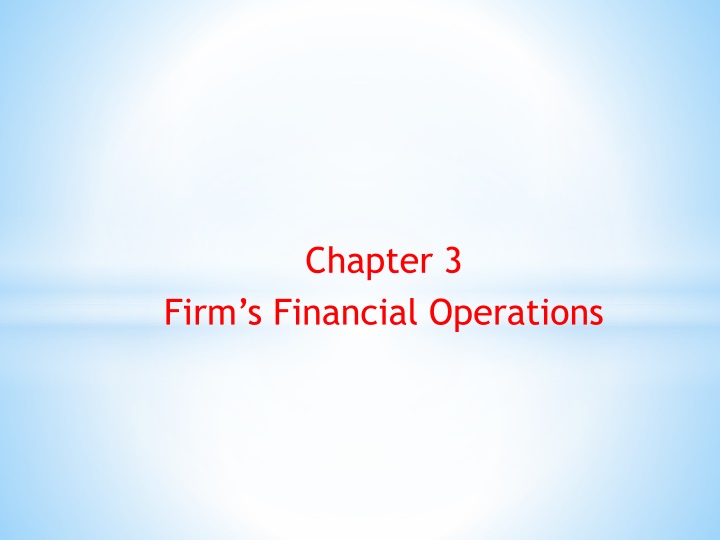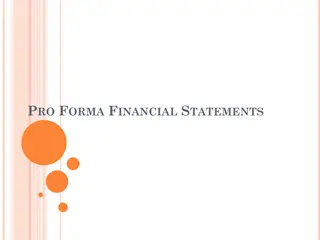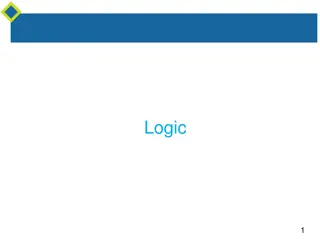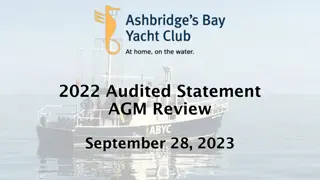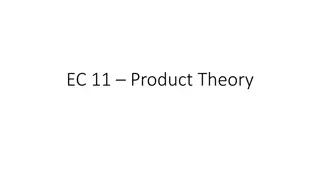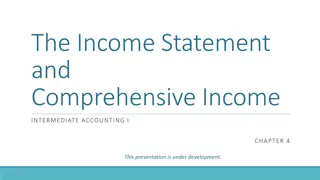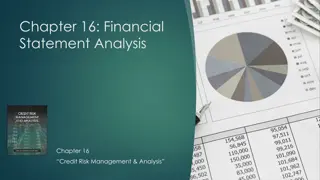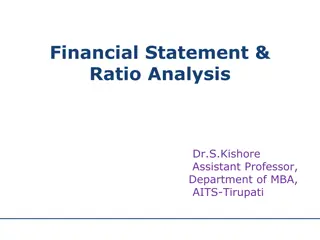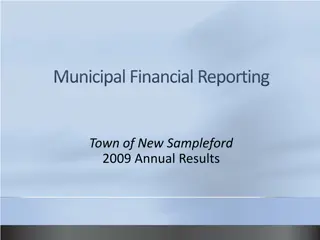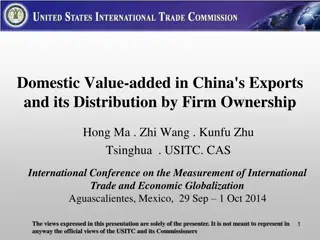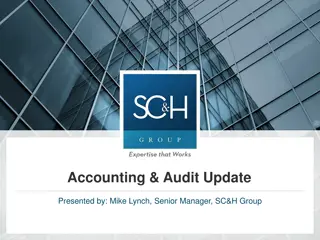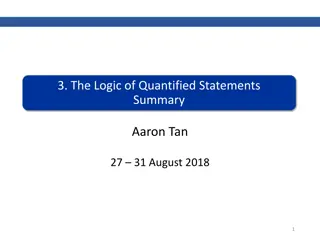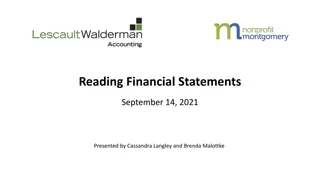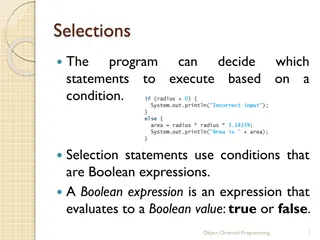Firm's Financial Operations: Financial Statements and Analysis
Financial statements play a crucial role in decision-making by providing a snapshot of a firm's financial activities. They help stakeholders understand historical performance, forecast future actions, and assess creditworthiness. These statements inform management, shareholders, investors, lenders, and government agencies about the firm's financial position and performance.
Download Presentation

Please find below an Image/Link to download the presentation.
The content on the website is provided AS IS for your information and personal use only. It may not be sold, licensed, or shared on other websites without obtaining consent from the author.If you encounter any issues during the download, it is possible that the publisher has removed the file from their server.
You are allowed to download the files provided on this website for personal or commercial use, subject to the condition that they are used lawfully. All files are the property of their respective owners.
The content on the website is provided AS IS for your information and personal use only. It may not be sold, licensed, or shared on other websites without obtaining consent from the author.
E N D
Presentation Transcript
Chapter 3 Firm s Financial Operations
Firms Financial Operations 1. Financial Statements 2. Financial Analysis 3. Cash Flow Management 4. Earned Value Management *Contents 2
*1. Financial Statements 1.1 General Financialinformation is vital for decisionmaking. In construction it is used to make a decision on the purchase of an equipment, land, etc. A financial Statement is a collection of monetary data and information organized according to logical and consistent accounting procedures. It provides understanding of what happens to the firm s money as the firm pursues its business activities. Financialstatementssummarize the financialactivities of the business. Financial statements paint a picture of the transactions that flow through the business. 3
*1. Financial Statements 1.1 General: Accounting System Accounting system collects and processesfinancial information. Reports information to decision makers: i.e. for Managers (internal); and Investors and Creditors (external). Accounting System Financial Accounting System Periodic financial statements and related disclosures Managerial Accounting System Detailed plans and continuous performance reports External Decision Makers Investors, creditors, suppliers, customers, etc. Internal Decision Makers Managers throughout the organization 4
*1. Financial Statements 1.2 Uses of Financial Statements Financial statements have the following uses to: Present a historicalrecord of the firm s financial development when complied over a number of years; Forecast a course of action for the firm. Financial statement is often prepared for a future period. It expresses the financial manager sestimate of the firm sfutureperformance; and A means employed by firms to present their financial situations to stockholders, creditors and the general public. 5
*1. Financial Statements 1.3 Purpose of Financial Statements The mainpurpose of financial statements is to inform the following parties of the financial performance and position of the entity: Management: for reviewing their performance during the reporting period; Shareholders: for assessing the worth of their investments and reviewing the effectiveness of the Management; Investors: for judging the worth of the entity before deciding to invest; Suppliers and Lenders: creditworthiness of the entity before deciding to extend credit; and Government: for calculating the amount of tax to be collected. judging for the 6
*1. Financial Statements 1.4 Forms of Financial Statements Financial statements take up one of the following forms: Balance sheet; Income statement; and Cash flow (Flow of fund) statement. 1.4.1 Balance Sheet The balancesheet is a statement which shows the financial position of a company at the endof a certain reportingperiod, which is the fiscal year. It mainly shows the assets, liabilities and stockholders equity, based on the accounting equations: Assets = Liabilities + Owner s equity It declares the assets, liabilities and equity for the firm at the last day of the accounting period, It matchesresources (assets) with sources (liabilities and equity). 7
*1. Financial Statements 1.4 Forms of Financial Statements 1.4.1 Balance Sheet A. Assets Asset representshowmuch a companyowns at a given time of reporting, usually the budget year. i. Current Assets: It includes cash and properties that can be convertedtocash in less than a year. Cash at hand, in bank or in the form of marketable securities & short form investments; Accountsreceivable: money due but not yet received: o Approved payment certificates; and o Materials delivered. Inventory: amount invested for purchasing materials, materials on site, Paid delivery orders, etc. 8
*1. Financial Statements 1.4 Forms of Financial Statements 1.4.1 Balance Sheet A. Assets ii. Fixed Assets: These are permanentproperties, which can not be easily converted to cash within a year, Plant and Equipment: This includes building, cars, machinery and other equipments and are adjusted by the depreciation record. RealEstate (if any): This account lists the property owned by the firm. (Land) 9
*1. Financial Statements 1.4 Forms of Financial Statements 1.4.1 Balance Sheet B. Liabilities Liabilities are funds that a companyowes like loans. It representssources of assets since the firm either borrows the money or make use of certain assets that have not yet been paid for. i. Current Liabilities All debts that needtobesettled in a veryshortperiod, usually within a year like accounts and notes payable in a year, accrued expenses which include: Accountspayable: when a firm makes purchase on credit, Short-termnotespayable: promissory notes that mature in one year, Otherpayables: accruals (wages payable), tax liabilities. 10
*1. Financial Statements 1.4 Forms of Financial Statements 1.4.1 Balance Sheet B. Liabilities ii. Long Term Liabilities Liabilities that will notbepaidoffduring the nextyear. This includes the long-Termsecured and unsecuredfinancing which covers mortgage and notes where a building or other Fixed assets are pledged as specific collateral for debts. C. Stock Holders Equity This is part of the assets of the company, which is providedby the owners (investors). Thus it is considered as a liability to the company. Preferred Stock, Common Stock, Contributed or paid in capital, and Retained earnings. 11
*1. Financial Statements 1.4 Forms of Financial Statements 1.4.2 Income Statement It is a form of financial statement that shows whether the companyhasmade or lostmoney during that reporting period. Income statements canbepreparedmonthly, quarterly, etc. However, usual accountingperiodsextend to one year, which is the fiscalyear. It shows the revenues and expenses of the firm, the effect of interest and taxes and the net income for the period. It may be called as the profit-and-lossstatement or the statement of earnings. 12
*1. Financial Statements 1.4 Forms of Financial Statements 1.4.2 Income Statement The balance sheet offers a view of the firm at a moment in time, whereas the income statement summarizes the profitability of operations over a period of time. It is an accounting device designated to show stockholders and creditorswhether the firm is making money. It can also be used as a tool to identify the factors that affect the degree of profitability. 13
*1. Financial Statements 1.4 Forms of Financial Statements 1.4.2 Income Statement A. Revenue Revenues are earnings from the sale of goods or services to customers. Revenue is recognized in the period in which goods and services are sold, notnecessarily the period in which cash is received. B. Expense Expenses are the dollar amount of resourcesused up by the entity to earn revenues during a period. An expense is recognized in the period in which goods and services are used, notnecessarily the period in which cash is paid. 14
*1. Financial Statements 1.4 Forms of Financial Statements 1.4.3 Cash Flow Statement The incomestatementshowshowmuch the company has lost or gained, but does notindicatefinancing and investmentactivities during the period. Therefore, an additionalfinancialstatement is required which can showhow the companygenerated the cash and how it has spent or utilizedit. This statement is known as the cashflowstatement. 15
*1. Financial Statements 1.4 Forms of Financial Statements 1.4.3 Cash Flow Statement Cashflow statement shows the movement of funds into the firm scurrentassetaccounts from external sources such as stockholders, creditors and customers. It also shows the movement of funds to meet the firm s obligation, or pay dividends. The movements are shown for a specific period, normally the same time period as the firm s income statement. 16
*1. Financial Statements 1.5 Reporting Format 1.5.1 Operating Activities The operatingcashflow represents all cash flows related to the production and sales of goods and services. All non-cash expenses bill depreciation is added back incomes to the net profit. Any working capital adjustment is also included here. For instance; if currentliabilitiesincreases and exceed current assets additionalfinancing is required. 1.5.2 Investing Activities These include cash flow related to: Purchase of new fixed assets (outflow); and Reselling an old equipment (inflow). 17
*1. Financial Statements 1.5 Reporting Format 1.5.3 Financing Activities These include cash flow related to: Purchasingstocks (outflow); Sellingstocks (inflow); and Payingloans (outflow). 18
*1. Financial Statements 1.5 Reporting Format: Summary BalanceSheet 2 1 CapitalSupplied LIABILITIES Current Long-term) ASSETS Current (Short-term) Fixed (long-term) Other Debt Shareholder s EQUITY Stock Cash Flow Retain Return Sell Equity Issue Debt <Buy Assets> <Buy Inventory> Make Sales! <Pay Costs> <Pay Taxes> <Pay Interest> <Pay Dividends> 3 4 Retain profits or repay debt-holders (with interest) and stockholders (with dividends) 19
*1. Financial Statements 1.6 Sample: Financial Statements (Balance Sheet) Owns Owes Assets Liabilities and Equity Current liabilities: Payables Short-term debt Long-term liabilities Shareholders' equity Current assets: Cash & securities Receivables Inventories Fixed assets: Tangible assets Intangible assets 20
*1. Financial Statements Addis-Matador CORP. Balance Sheet At December 31, 2006 (in thousands of dollars) Assets 1. Name of entity 2. Title of statement 3. Specific date 1.6 Sample: Financial Statements (Balance Sheet) 4. Unit of measure Cash Accounts receivable Inventories Plant and equipment Land Total assets Liabilities and Stockholders' Equity Liabilities Accounts payable Notes payable Total liabilities Stockholders' Equity Contributed capital Retained earnings Total stockholders' equity Total liabilities and stockholders' equity 4,895 5,714 8,517 7,154 981 27,261 $ $ The Balance Sheet reports the financial position of an entity at a particular point in time. 7,156 $ 9,000 16,156 $ 2,000 $ 9,105 11,105 27,261 $ 21
*1. Financial Statements Balance Sheet At December 31, 2006 (in thousands of dollars) Assets Addis-Matador CORP. 1.6 Sample: Financial Statements (Balance Sheet) Cash Accounts receivable Inventories Plant and equipment Land Total assets Liabilities and Stockholders' Equity Liabilities Accounts payable Notes payable Total liabilities Stockholders' Equity Contributed capital Retained earnings Total stockholders' equity Total liabilities and stockholders' equity 4,895 5,714 8,517 7,154 981 27,261 $ $ Use $ on the first item in a group and on the group total. 7,156 $ 9,000 Assets = Liabilities + Stockholders Equity 16,156 $ 2,000 $ 9,105 11,105 27,261 $ 22
*1. Financial Statements Addis-Matador CORP. Income Statement For the Year Ended December 31, 2006 (in thousands of dollars) accounting period. The Income Statement reports the 1.6 Sample: Financial Statements (Balance Sheet) revenues less expenses of the Revenues Sales revenue Expenses Cost of goods sold Selling, general and administrative Research and development Interest expense Total expenses Pretax income Income tax expense Net income 37,436 $ 26,980 $ 3,624 1,982 450 33,036 4,400 $ 1,100 3,300 $ 23
*1. Financial Statements Addis-Matador CORP. Income Statement For the Year Ended December 31, 2006 (in thousands of dollars) 1.6 Sample: Financial Statements (Balance Sheet) Revenues Sales revenue Expenses Cost of goods sold Selling, general and administrative Research and development Interest expense Total expenses Pretax income Income tax expense Net income expense income. Cost of goods sold Selling, general and administrative The cost to produce products sold this period. Production costs: direct costs 37,436 $ Operating expenses not directly related to production. 26,980 $ 3,624 1,982 Research and development Interest expense Income tax Expenses incurred to develop new products. 450 33,036 4,400 $ 1,100 3,300 $ The cost of using borrowed funds. Income taxes on current period s pretax 24
*1. Financial Statements 1.6 Sample: Cash Flow Statements The Statement of CashFlowsreports the inflows and outflows of cash during the period in the categories of operating, investing, and financing. Cash Flow Statement Classifications Natural Cash Flows Sell Equity Issue Debt <Pay Dividends> Sell Equity Issue Debt Financing <Buy Assets> <Buy Inventory> Investing <Buy Assets> Make Sales! <Pay Costs> <Pay Taxes> Make Sales! <Buy Inventory> <Pay Costs> <Pay Taxes> <Pay Interest> =NET CASH FLOW Operating <Pay Interest> <Pay Dividends> 25
*1. Financial Statements 1.6 Sample: Cash Flow Statements Cash flows from operating activities: Cash collected from customers Cash paid to suppliers and employees Cash paid for interest Cash paid for taxes Net cash flow from operating activities Cash flow from investing activities: Cash paid to purchase equipment Net cash flow from investing activities Cash flow from financing activities: Cash received from bank loan Cash paid for dividends Net cash flow from financing activities Net decrease in cash during the year Cash at beginning of the year Cash at end of the year 33,563 (30,854) (1,190) $ (450) $ 1,069 $ (1,625) (1,625) $ 1,400 (1,000) $ $ 400 (156) 5,051 4,895 26
*1. Financial Statements 1.7 Relationship Among Financial Statements Addis-Matador CORP. Income Statement For the Year Ended December 31, 2006 (in thousands of dollars) Net income from the income statement increases ending retained earnings on the statement of retained earnings. Revenues Sales revenue Expenses Cost of goods sold Selling, general and administrative Research and development Interest expense Total expenses Pretax income Income tax expense Net income 37,436 $ 26,980 $ 3,624 1,982 450 33,036 4,400 $ 1,100 3,300 $ Addis-Matador CORP. Statement of Retained Earnings For the Year Ended December 31, 2006 (in thousands of dollars) Retained earnings, January 1, 2006 Net income for 2006 Dividends for 2006 Retained earnings, December 31, 2006 6,805 $ 3,300 (1,000) 9,105 $ 27
*1. Financial Statements 1.7 Relationship Among Financial Statements Addis-Matador CORP. Balance Sheet At December 31, 2006 (in thousands of dollars) Assets Ending retained earnings from the statement of retained earnings is one of the components of stockholders equity on the balance sheet. Cash Accounts receivable Inventories Plant and equipment Land Total assets Liabilities and Stockholders' Equity Liabilities Accounts payable Notes payable Total liabilities Stockholders' Equity Contributed capital Retained earnings Total stockholders' equity Total liabilities and stockholders' equity 4,895 5,714 8,517 7,154 981 27,261 $ $ 7,156 $ 9,000 Addis-Matador CORP. Statement of Retained Earnings For the Year Ended December 31, 2006 (in thousands of dollars) 16,156 $ 2,000 $ 9,105 11,105 27,261 $ Retained earnings, January 1, 2003 Net income for 2003 Dividends for 2003 Retained earnings, December 31, 2003 6,805 $ 3,300 (1,000) 9,105 $ 28
*1. Financial Statements 1.7 Relationship Among Financial Statements Addis-Matador CORP. Balance Sheet At December 31, 2006 (in thousands of dollars) Assets Addis-Matador CORP. Statement of Cash Flows For the Year Ended December 31, 2006 (in thousands of dollars) Cash Accounts receivable Inventories Plant and equipment Land Total assets Liabilities and Stockholders' Equity Liabilities Accounts payable Notes payable Total liabilities Stockholders' Equity Contributed capital Retained earnings Total stockholders' equity Total liabilities and stockholders' equity 4,895 5,714 8,517 7,154 981 27,261 $ $ Cash flows from operating activities: Cash collected from customers Cash paid to suppliers and employees Cash paid for interest Cash paid for taxes Net cash flow from operating activities Cash flow from investing activities: Cash paid to purchase equipment Net cash flow from investing activities Cash flow from financing activities: Cash received from bank loan Cash paid for dividends Net cash flow from financing activities Net decrease in cash during the year Cash at beginning of the year Cash at end of the year 33,563 (30,854) (1,190) $ (450) $ 1,069 $ (1,625) 7,156 $ 9,000 (1,625) $ 1,400 (1,000) 16,156 $ 2,000 $ 9,105 $ $ 400 (156) 5,051 4,895 11,105 27,261 $ The change in cash on the statement of cash flows added to the beginning of the year balance in cash equals the ending balance in cash on the balance sheet. 29
*2. Financial Analysis 2.1 General Financial analysis is done to find firm sfinancial strengths and weaknesses through the assessment of the firm spast, present and futurefinancialconditions If properly analyzed and interpreted, financial statements can provide valuable insights into a firm s performance. Analysis of financialstatements is of interest to: Lenders (short-term as well as long-term); Investors; Security analysts; and Managers, public and others. 30
*2. Financial Analysis 2.1 General Financial statements analysis is helpful in assessing: Corporate excellence; Judging creditworthiness; Forecasting bond ratings; and Predicting bankruptcy and assessing market risks. Primary Tools: Financial Statements; and Comparison of financialratios to past, industry, sector and all firms. 31
*2. Financial Analysis 2.1 General 2.1.1 Common Size Financial Statements Each component of the statement is represented in terms of percentages. Incomestatement: each item is calculated as a percent of net sales Balancesheet: each item is calculated as a percent of assets or total liabilities and stockholder s equity. 2.1.2 Comparative (Common-Base Statements Financial information reported side by side in vertical columns to see relationship and trends between years i.e. TrendAnalysis. Horizontalanalysisshowsbirr and percentchanges from year to year. year) Financial 32
*2. Financial Analysis 2.1 General 2.1.3 Financial Statements Ratio Comparison It should analyzeratiosbaseduponstandards of comparison such as: Industryratios and standards; Similarbusinesses in the same industry (competition); Pastperformance ratios; and Prioryears operating results. 33
*2. Financial Analysis 2.2 Debt Management Analysis (Leverage Ratio) This helps to seehow a companymanages or uses its debt and its ability to meet its repaymentobligations. 2.2.1 Debt Ratio (DR) The ratio of total debts to total assets: measures the percentage of fundsprovided by creditors. Total Debt = Debt Ratio Total Assets This shows the proportion of the company s asset that has been financed through debt. If DR = 1, it implies that all assets are financed through debt. A firm has to try to keepDRaslowaspossible to attract furtherfinancing from creditors. 34
*2. Financial Analysis 2.2 Debt Management Analysis (Leverage Ratio) 2.2.2 Times Interest Earned Ratio (TIER) The ratio of earnings before interest and taxes (EBIT) to interest charges; a measure of the firm sability to meet its annualinterestpayments. EBIT = Interest Coverage Ratio Interest charges This shows the extent of decline of operating income before the firm is unable to meet its annual interest costs. TIER earning before interest and income tax are used as the company must pay interest with pre-tax earnings and income taxes do not affect current interest as they are subject to income tax. This ratio is very helpful for longtimecreditors. 35
*2. Financial Analysis 2.3 Liquidity Analysis Working capital is the excess of current assets to current liabilities. It means that there exists a convertible asset to meet current obligations. The networkingcapitalshows the extent of the liquidity of the company. Liquidity or the amount of working capital of a company is of interest to shorttermcreditors as they need their payments to be effected in a short period of time. 2.3.1 Current Ratio A good value of current ratios is difficult to give, but it is good if it ranges between 1 and 2. It mainly depends on the nature of operation and composition of assets existing. Current Current assets = Current Ratio liabilitie s 36
*2. Financial Analysis 2.3 Liquidity Analysis 2.3.2 Quick or Acid Test Ratio It is calculated by deducting inventory from current assets as a proportion of current liabilities It shows the ability of the company to settle its current liabilitiesimmediately. Good value is greater than 1. Current assets - Inventorie s = Quick Ratio Current liabilitie s 37
*2. Financial Analysis 2.4 Asset Management Analysis The asset management ratios measures how effectively the firm is managing its assets. Too many assets:- to highcost of capital; and Too low assets:- lessprofitable sales. 2.4.1 Inventory Turnover Ratio (ITR) It measureshowmanytimes the companysold and replaced its inventory during the period. The higherITR the less stock holding & money is not tied. Sales = Inventory Turnover Ratio Inventorie s 38
*2. Financial Analysis 2.4 Asset Management Analysis 2.4.2 Days Sales Standing Ratio (DSSR) It shows the averagecollectionperiod of credits. The lesseritis the moreturnover it makes. Accounts Receivable = Days Sales Standing Ratio Turnover 2.4.3 Total Assets Turnover Ratio (TATR) It shows how effectively the totalassets are used to generaterevenues. The lesser the value of TATR the more is the investment on inventory, plant and equipment and is not good. Measures how efficiently assets are employed. Ratio Turnover Asset Total Sales = Total Assets 39
*2. Financial Analysis 2.4 Asset Management Analysis 2.4.4 Fixed Assets Turnover Ratio (FATR) It measures how efficientlyfixedassets are employed Sales = Fixe Asset Turnover Ratio Net fixed assets 40
*2. Financial Analysis 2.5 Profitability Analysis This is a method to showhowprofitable a company is. A groupofratios that show the combinedeffects of liquidity, assetmanagement, and debt on operating results. 2.5.1 Gross Profit Margin Ratio (GPMR) This ratio shows the marginleft after meeting production costs. It measures the efficiency of production and pricing. Lowervaluesindicatelessefficientoperation, heavy debt and largeinventory volume. Margin Profit Gross Gross profit = Income 41
*2. Financial Analysis 2.5 Profitability Analysis 2.5.2 Return on Capital Employed (Total Assets) Ratio A measure of howefficiently the capital is employed. A key indicator of profitability of a firm. Firms that are efficientlyusing their assets have a relatively highreturn i.e. higher values indicate lower debt and highearning. Less efficient firms have a lowerreturn. Net profit = Return Capital on Employed Current Assets 42
*2. Financial Analysis 2.5 Profitability Analysis 2.5.3 Return on Equity Ratio (FATR) Profit indicator to shareholders. The ratio indicates the degree to which the firm is able to convertequity to generatenetprofit that eventually can be claimed by shareholders. It shows how much income is gainedper unit stockholdersinvestment. Net profit = Return Equity on Total equity 43
*2. Financial Analysis 2.6 Market Value Analysis When one purchases a stock from a company one is interested on: How liquid the stock is to resell; and How much dividend it can generate. 2.6.1 Price Earning Ratio (P/E) P/E ratios will be higher for positiveprospects of a company or potentially prospering companies. 2.6.2 Book Value per Share(BVS) It is the measure of the amountdistributed to stockholders per share (BVS). 44
*2. Financial Analysis 2.6 Market Value Analysis 2.6.3 Industry Average Values of Ratios In construction rule of thumb acceptable ratio values are: Current ratio > 1.3; Quick ratio > 1.1; Debt to worth > 2; and Debt ratio: Receivables to payables > 1.5; and Receivables to payables > 3.0 (labor intensive). o o 45
*3. Cash Flow Management 3.1 Definitions CashFlow:- the netflow of funds into or out of a project. The sum, in any time period, of all cash receipts, expenses, and investments. Also called cashproceeds or cash generated. Baseline:- in project control, the referenceplans in which cost, schedule, scope and other project performance criteria are documented and against which performancemeasures are assessed and changesnoted. Costbudgeting:- allocating the overallcostestimate to individualworkitems to establish a baseline for measuring performance. 46
*3. Cash Flow Management 3.1 Definitions CostControl:- controllingchanges to the projectbudget. ProjectBudget:- estimatedresourceexpenditures during a given period for a project or activity. Resources may include cost, hours, quantities, etc. The budget may also include a systematicplan for the expenditure of the resources. 47
*3. Cash Flow Management 3.2 Project Cash Flow Project Cash Flows represent the manner in which projects are executed. It shows the transfer of money from one party to the other. Project cash flows are means for planning for financing and used as a controllingtool. Cash flows are prepared for: Client: for budgetary purposes; and Contractor: depicting the manner of execution of works, cash inflows and outflows for resources and preparing additional funds for deficits. 48
*3. Cash Flow Management 3.3 Timing for Cash Flow Planning Similar to other management tools, cash flow planning is a repeated process and hence it is prepared during the:- Initialstage to compile a forecast plan or baseline or target plan, and Progress of construction to measure the performance and compare it with the originalplan. 3.4 Inputs for Cash Flow Planning and Management The minimuminputs required to create the baseline reference (BaselineSCurve) for subsequent project monitoring and control: BaselineSchedule: it contains information about the actual start date and finish date as well as the information on proposed man-hours and expenditure allocations. ProductionSchedule (Cost accounting records): it contains information of the actual man-hours and expenditures incurred for a particular stage of the project. 49
*3. Cash Flow Management 3.5 Procedure to Cash Flow Preparation The grossbillvalue (contract amount) and its time of submission (S- curve): Direct cost; and The margin. The measurementperiod; it is usual for the contractors to be paid on a monthly basis. This is given in contacts in the TermsofPayment . Certificationtime taken allowed for in the contract. In most cases owner takes about 3-4weeks time to process the bill and release the payment to the contractor. 50
